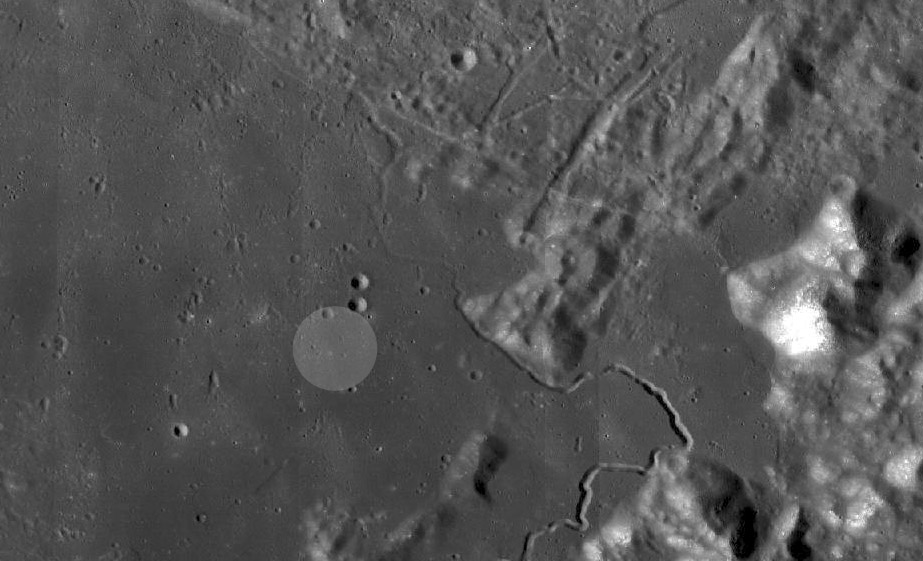Difference between revisions of "June 28, 2013"
| (One intermediate revision by the same user not shown) | |||
| Line 6: | Line 6: | ||
<em>LRO image from [mailto:http://target.lroc.asu.edu/q3/?proj=eqc&center=809800.536299,79802.236529998&zoom=8&lt=LocationOverlays=llgrid,F,70;moonsunlit,F,40;satview,F,;lroc_feat_images,F,;moon_ft,F,;=InstrumentFootprints=m3_fprints,F,50;nac_fprints,F,100;=SpecialProducts=lndtmcs,F,100;lndtms,F,100;lnpole,F,100;l_lro_mrf,F,100;l_ch1_mrf,F,100;lpjnac,F,100;=M3GlobalMosaics=m3_mosaic_op2c3,F,100;m3_mosaic_op2c2,F,100;m3_mosaic_op2c1,F,100;m3_mosaic_op2b,F,100;m3_mosaic_op2a,F,100;m3_mosaic_op1b,F,100;m3_mosaic_op1a,F,100;=M3SphModelGlobalMosaics=m3_mosaic_sph_op2c3,F,100;m3_mosaic_sph_op2c2,F,100;m3_mosaic_sph_op2c1,F,100;m3_mosaic_sph_op2b,F,100;m3_mosaic_sph_op2a,F,100;m3_mosaic_sph_op1b,F,100;m3_mosaic_sph_op1a,F,100;=Basemaps=lclem_mr,F,100;wac_demclrshd2_128ppd,F,30;lnbrowse,F,100;wac_bw_v1_par,F,100;wac_bw_v1_plus_nacs,T,100;= QuickMap] of area [http://www.amazon.com/International-Atlas-Lunar-Exploration/dp/052181930X/ref=sr_1_2?s=books&ie=UTF8&qid=1372384135&sr=1-2 Phil Stooke] proposes might include the touchdown site of Luna 2</em><br /> | <em>LRO image from [mailto:http://target.lroc.asu.edu/q3/?proj=eqc&center=809800.536299,79802.236529998&zoom=8&lt=LocationOverlays=llgrid,F,70;moonsunlit,F,40;satview,F,;lroc_feat_images,F,;moon_ft,F,;=InstrumentFootprints=m3_fprints,F,50;nac_fprints,F,100;=SpecialProducts=lndtmcs,F,100;lndtms,F,100;lnpole,F,100;l_lro_mrf,F,100;l_ch1_mrf,F,100;lpjnac,F,100;=M3GlobalMosaics=m3_mosaic_op2c3,F,100;m3_mosaic_op2c2,F,100;m3_mosaic_op2c1,F,100;m3_mosaic_op2b,F,100;m3_mosaic_op2a,F,100;m3_mosaic_op1b,F,100;m3_mosaic_op1a,F,100;=M3SphModelGlobalMosaics=m3_mosaic_sph_op2c3,F,100;m3_mosaic_sph_op2c2,F,100;m3_mosaic_sph_op2c1,F,100;m3_mosaic_sph_op2b,F,100;m3_mosaic_sph_op2a,F,100;m3_mosaic_sph_op1b,F,100;m3_mosaic_sph_op1a,F,100;=Basemaps=lclem_mr,F,100;wac_demclrshd2_128ppd,F,30;lnbrowse,F,100;wac_bw_v1_par,F,100;wac_bw_v1_plus_nacs,T,100;= QuickMap] of area [http://www.amazon.com/International-Atlas-Lunar-Exploration/dp/052181930X/ref=sr_1_2?s=books&ie=UTF8&qid=1372384135&sr=1-2 Phil Stooke] proposes might include the touchdown site of Luna 2</em><br /> | ||
<br /> | <br /> | ||
| − | The world has been amazed by the hyper resolution LRO images that show the Apollo landing modules and rovers on the lunar surface. In fact, the LRO camera team has been searching for all of the spacecraft that have landed or crashed on to the Moon. In a great [http://www.space.com/18905-moon-spacecraft-dumping-ground-infographic.html graphic] that can be embedded on websites (such as the [https://the-moon.us/wiki/ | + | The world has been amazed by the hyper resolution LRO images that show the Apollo landing modules and rovers on the lunar surface. In fact, the LRO camera team has been searching for all of the spacecraft that have landed or crashed on to the Moon. In a great [http://www.space.com/18905-moon-spacecraft-dumping-ground-infographic.html graphic] that can be embedded on websites (such as the [https://the-moon.us/wiki/Lunar_Graveyard Moon Wiki]) Space.com shows that 71 spacecraft and spacecraft parts are on the Moon. Wikipedia also has a [http://en.wikipedia.org/wiki/List_of_man-made_objects_on_the_Moon list] of 75 man-made objects on the Moon. The WIkipedia list includes links to LRO images showing 13 of the objects; although I must say that the list is not up to date since the impact spots of Grail and a few other probes are imaged. Nonetheless, most human probes that reached the Moon have not yet been detected. And that isn't surprising because the space vehicles and the probe impact craters are small - a few meters across. In another Space.com [http://www.space.com/21723-lost-moon-probes-hunt-lro.html article], LRO scientists Mark Robinson and Jeff Plescia talk about the objects they are most looking for: Luna 9, 13 and 18, as well as Surveyor IV. They don't mention Luna 2, which was the first probe to reach the Moon, and the grandest prize of lunar exploration rediscovery. But nobody knows within tens of kilometers where it hit the Moon. And if you have to search LRO Narrow Angle Camera frames at full half meter resolution of all that area to have a chance of finding the impact point, that is a lot of pixels. Mark and Jeff are searching for their favorite missing probes, and so can you. Just go to [http://target.lroc.asu.edu/q3/ QuickMap] at the best guess location for the probe you want to look for, zoom in to the highest magnification, take a deep breath, and good luck!<br /> |
<br /> | <br /> | ||
<em>[mailto:tychocrater@yahoo.com Chuck Wood]</em><br /> | <em>[mailto:tychocrater@yahoo.com Chuck Wood]</em><br /> | ||
| Line 14: | Line 14: | ||
<br /> | <br /> | ||
<strong>Related Links</strong><br /> | <strong>Related Links</strong><br /> | ||
| − | Rükl plate [https://the-moon.us/wiki/R%C3% | + | Rükl plate [https://the-moon.us/wiki/R%C3%BCkl_22 22]<br /> |
| − | <em>[ | + | <em>[[21st Century Atlas of the Moon|21st Century Atlas]]</em> chart 11.<br /> |
<br /> | <br /> | ||
<p><b>Yesterday's LPOD:</b> [[June 27, 2013|Was This a Super Moon?]] </p> | <p><b>Yesterday's LPOD:</b> [[June 27, 2013|Was This a Super Moon?]] </p> | ||
Latest revision as of 07:30, 28 October 2018
Can You Find Luna 2?

LRO image from QuickMap of area Phil Stooke proposes might include the touchdown site of Luna 2
The world has been amazed by the hyper resolution LRO images that show the Apollo landing modules and rovers on the lunar surface. In fact, the LRO camera team has been searching for all of the spacecraft that have landed or crashed on to the Moon. In a great graphic that can be embedded on websites (such as the Moon Wiki) Space.com shows that 71 spacecraft and spacecraft parts are on the Moon. Wikipedia also has a list of 75 man-made objects on the Moon. The WIkipedia list includes links to LRO images showing 13 of the objects; although I must say that the list is not up to date since the impact spots of Grail and a few other probes are imaged. Nonetheless, most human probes that reached the Moon have not yet been detected. And that isn't surprising because the space vehicles and the probe impact craters are small - a few meters across. In another Space.com article, LRO scientists Mark Robinson and Jeff Plescia talk about the objects they are most looking for: Luna 9, 13 and 18, as well as Surveyor IV. They don't mention Luna 2, which was the first probe to reach the Moon, and the grandest prize of lunar exploration rediscovery. But nobody knows within tens of kilometers where it hit the Moon. And if you have to search LRO Narrow Angle Camera frames at full half meter resolution of all that area to have a chance of finding the impact point, that is a lot of pixels. Mark and Jeff are searching for their favorite missing probes, and so can you. Just go to QuickMap at the best guess location for the probe you want to look for, zoom in to the highest magnification, take a deep breath, and good luck!
Chuck Wood
Technical Details
If you are going to enter the probe rediscovery olympics you need training - the best way is to visit the spacecraft sites already identified - here is the LRO team list.
Related Links
Rükl plate 22
21st Century Atlas chart 11.
Yesterday's LPOD: Was This a Super Moon?
Tomorrow's LPOD: Keeping Up with the Smythiis
COMMENTS?
Register, Log in, and join in the comments.



